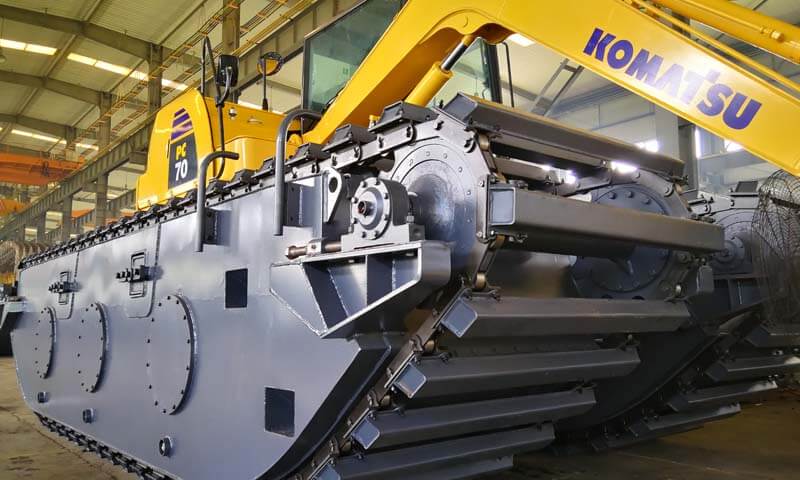Table of Contents
Amphibious excavator
With the development of the engineering industry, the field of construction machinery is also being subdivided. Amphibious excavators are new products between cutter suction boats and ordinary standard excavators. He takes into account the flexibility of ordinary excavators and the water use of cutter suction boats. It can not only satisfy the function of cutter suction boat digging in water, but also drive on land. It makes up for the disadvantage that the two can’t work in the mud. More and more engineering projects are incorporating amphibious excavators into their fleets as essential machinery.
But just like regular excavators, amphibious excavators come in many models and brands. How to choose the amphibious excavator that suits you?
Since the amphibious excavator is transformed from an ordinary excavator with an amphibious pontoon undercarriage, the upper body of the excavator is the same as that of an ordinary excavator. In this way, the brand of the excavator can follow the brand of the ordinary excavator, and the applicability is wider. However, excavators of different tonnages have different construction efficiency. Moreover, different projects have different requirements for amphibious excavators.
Let’s look at how to choose an amphibious excavator model from the aspects of tonnage, project content, and so on.
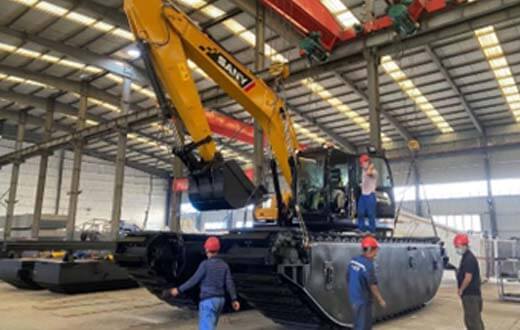
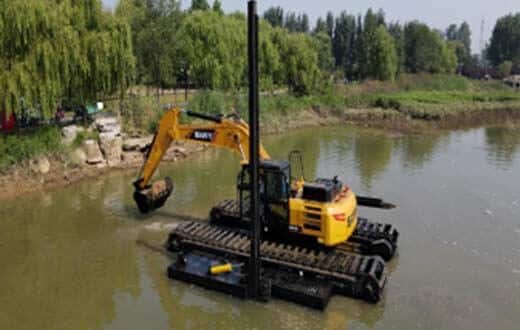
How to choose the tonnage of the amphibious excavator?
Many customers who want to buy amphibious excavators already have their own excavators. They only need to be retrofitted on the original excavator. At this time, his choice is relatively fixed, usually related to the tonnage of the excavator he owns.
If he owns two 20-ton excavators, he will probably choose to convert one of them into an amphibious excavator to adapt to more working conditions.
If you want to re-select a brand-new amphibious excavator, you will usually choose from the following three grades. 10 tons, 20 tons and 30 tons. These three levels cover most construction situations that can be encountered. Of course, some home users prefer amphibious excavators of about 5 tons.
In addition, it should be noted that the tonnage we are talking about refers to the tonnage of ordinary excavators. For example, the 20-ton class refers to CAT320, Komatsu PC210 and other models. When converted into an amphibious excavator, the total weight will exceed 30 tons, but we still call it a 20-ton amphibious excavator.
This level of amphibious excavator can definitely be said to be a mini-level amphibious excavator. Because if you choose to use a small-scale excavator, you will lose the meaning of modification. Although it is small, its function is the same as that of a large amphibious excavator. Many customers also require this level of amphibious excavator to have the function of fully floating.
Of course, he may not need auxiliary equipment such as side pontoons and hydraulic spuds, and only needs the main pontoon to realize the fully floating function. It can still play a big role in dealing with the leaves of family ponds and swimming pools.
Entering the 10-ton amphibious excavator belongs to the category of small excavators. In order to save money, some small engineering projects can choose this level of amphibious excavator. Although the work efficiency is lower, but because the amount of small works is not large and the construction period is not long, amphibious excavators of this level can also be competent. Moreover, in some urban engineering projects, larger amphibious excavators are not flexible enough. This small amphibious excavator is more than capable of functioning.
Whether the 20-ton excavator is ordinary or amphibious, it is a conventional excavator. It is the largest and most common model in various construction projects. This level of amphibious excavator is also a standing model in the factory. Semi-finished products are usually stored in order to shorten the lead time. Since 20-ton ordinary excavators are already very common, the proportion used to change them into amphibious excavators is also the highest.
This level of amphibious excavator is a large machine. In addition to meeting the applicable working conditions of a 20-ton amphibious excavator, it has higher excavation efficiency, can be equipped with a long reach arm, and has a larger bucket capacity. Some engineering projects that focus on excavation efficiency prefer 30-ton amphibious excavators. This is also the second most popular model after the 20-ton amphibious excavator.
This level of excavator can be described as a giant. This is also the largest model of amphibious excavator modification. Usually, only mining customers will choose to modify this level of amphibious excavator. Because mining customers have many large excavators themselves, and they pay special attention to excavation efficiency.
Of course, the safety design of a 40-ton amphibious excavator is more cautious than that of other tonnage excavators. Usually need to be designed individually according to the specific working environment. Especially if fully floating operations are required, safety is even more important.
How to choose the auxiliary equipment of the amphibious excavator?
In addition to the main pontoon, the amphibious excavator can also expand its functions by adding side pontoons, hydraulic spuds, hydraulic propellers and other auxiliary equipment to increase the scope of applicable construction.
In addition, by modifying the long reach boom and adding necessary attachments, the amphibious excavator can also undertake dredging projects that cannot be undertaken by ordinary excavators.
Amphibious excavators mainly use many attachments, and the common ones are as follows:
Bucket
Buckets are the most commonly used attachment. Buckets are essential in excavation operations. After matching with the long reach boom, the bucket capacity of the bucket will be reduced, but it is still the most important digging tool. If you want to improve efficiency, you can only choose a larger tonnage amphibious excavator.
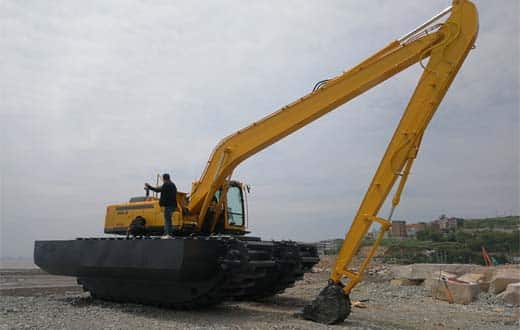
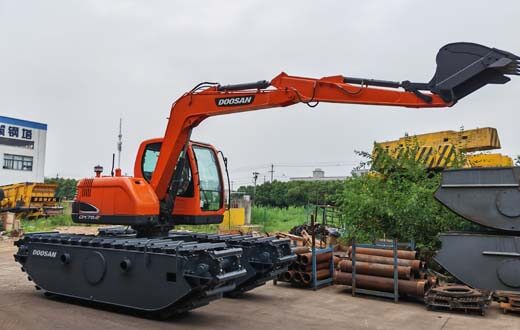
Cutter suction pump
Cutter suction pumps are very common in amphibious excavator applications. In addition to carrying out dredging projects, he can also carry out sand pumping, mud pumping and other operations. Cutter suction pumps work more efficiently than buckets. Cutter suction pumps are a better choice for projects that require large volumes of sludge to be pumped from the river bottom.
Other
In addition to the commonly used attachments for dredging, amphibious excavators are also capable of performing other types of engineering projects. Such as piling. Therefore, in some piling projects near water, amphibious excavators can also be seen. Install a piling hammer on the end of the long reach arm, and the amphibious excavator will be transformed into a pile driver, and the pile driving operation will be performed like an ordinary excavator.
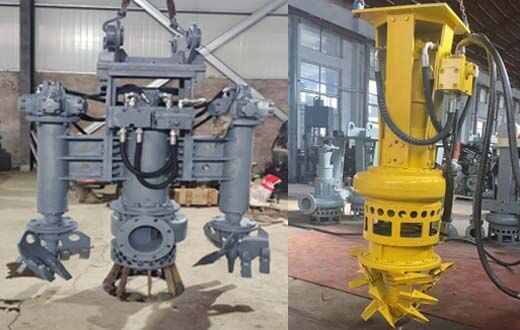
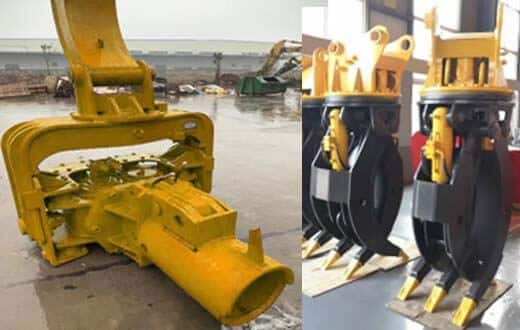
Of course, the basis of an amphibious excavator is an ordinary excavator, and other attachments applicable to ordinary excavators are also applicable to amphibious excavators. There are many more attachments that can be developed.
Under the working conditions of using different attachments, the required amphibious excavator configurations are also different. For example, if you are working with a bucket, you need a reaction force. When in a deep-water environment, it is necessary to add hydraulic spuds auxiliary equipment to ensure the support of the amphibious excavator.
When working with a cutter suction pump, there is no such requirement. Even when carrying out construction in deep water areas, hydraulic spuds may not be required. However, adding side pontoons to increase buoyancy and maintaining the stability of the amphibious excavator is essential.
When selecting auxiliary equipment for an amphibious excavator, the main consideration is whether stability and support points are required during construction. Choose different auxiliary equipment according to different working conditions to meet the stability required during construction, so as to complete the project with the highest work efficiency.
Summarize
It can be seen from the above analysis that if you want to choose the model and auxiliary equipment of the amphibious excavator, it is mainly related to the equipment you already have and the content of the engineering project.
If you already have an ordinary excavator, you only need to modify it directly.
If you need to re-purchase the entire amphibious excavator, it also depends on the specific construction project.
If you need to use a cutter suction pump in deep water, it is also necessary to add side pontoons to increase buoyancy.
Generally speaking, the selection of amphibious excavator models and auxiliary equipment is relatively simple. If you don’t know how to choose, you can consult the manufacturer directly. They will recommend suitable models and auxiliary equipment to you based on experience.

